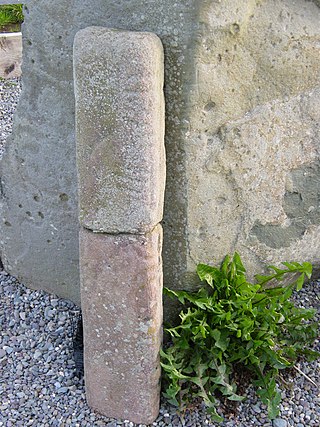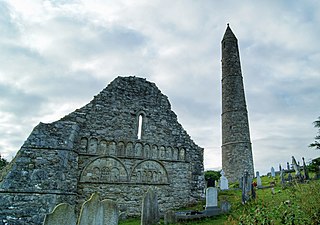
Carrigagulla is a megalithic complex 2.9 km north-east of Ballinagree, County Cork, Ireland.

Margam Stones Museum is a small Victorian schoolhouse near Port Talbot, South Wales, which now provides a home for one of the most important collections of Celtic stone crosses in Britain. All originally found within the locality of Margam, and mostly assembled as a collection in the 19th century, they provide enduring testimony to a Welsh Christian culture between the 6th and 16th centuries. The striking Cross of Conbelin is the most celebrated example. From around 1000 AD, it is a huge disc cross with Celtic interlace and plaitwork patterns, figurative scenes including a hunting scene, and inscriptions telling us who made it and who erected it. There are 17 early Christian stones, plus 11 memorials and other stones from the post-Norman periods. The museum is run by Cadw, the Welsh historic sites agency, and is close to Margam Abbey Church and the ruins of the Abbey buildings.
Drummin fort is a ringfort and National Monument located in County Roscommon, Ireland.
Drumlohan souterrain and ogham stones, known locally as the Ogham Cave, is a souterrain with ogham stones forming a National Monument located in County Waterford, Ireland.
Greenhill Ogham Stones are two ogham stones forming a National Monument located in County Cork, Ireland.
Breeny More Stone Circle is an axial stone circle and National Monument located in County Cork, Ireland.
Cloghanecarhan is a ringfort and ogham stone forming a National Monument located in County Kerry, Ireland.

Ratass Church is a medieval church with ogham stone inscriptions in Tralee, County Kerry, Ireland. It is a National Monument.

The Ardcanaght Stones are a pair of ogham stones forming a National Monument located in County Kerry, Ireland.

Dunloe Ogham Stones is a collection of ogham stones forming a National Monument located in County Kerry, Ireland.
Gallaunmore is a standing stone and National Monument located in County Kerry, Ireland.

Kilcoolaght East Ogham Stones are a collection of ogham stones forming a National Monument located in County Kerry, Ireland.
The Darrynane Beg Ogham Stone is an ogham stone and a National Monument located in County Kerry, Ireland.
St. Manchan's Oratory, also called An Teampall Geal is a medieval oratory and National Monument in County Kerry, Ireland.
Maumanorig or Kilcolman is the site of the remains of a medieval Christian monastery and National Monument located on the Dingle Peninsula, County Kerry, Ireland.

Ballywiheen is a medieval Christian site and National Monument located on the Dingle Peninsula, Ireland.

Kilmalkedar is a medieval ecclesiastical site and National Monument located in County Kerry, Ireland.
Carrowcrom Wedge Tomb is a wedge-shaped gallery grave and National Monument located in County Mayo, Ireland.
The Emlagh East Ogham Stone, also called the Priest's Stone is an ogham stone and a National Monument located in County Kerry, Ireland.

St. Declan's Monastery, containing the remains of Ardmore Cathedral, is a former monastery and National Monument located in County Waterford, Ireland.









